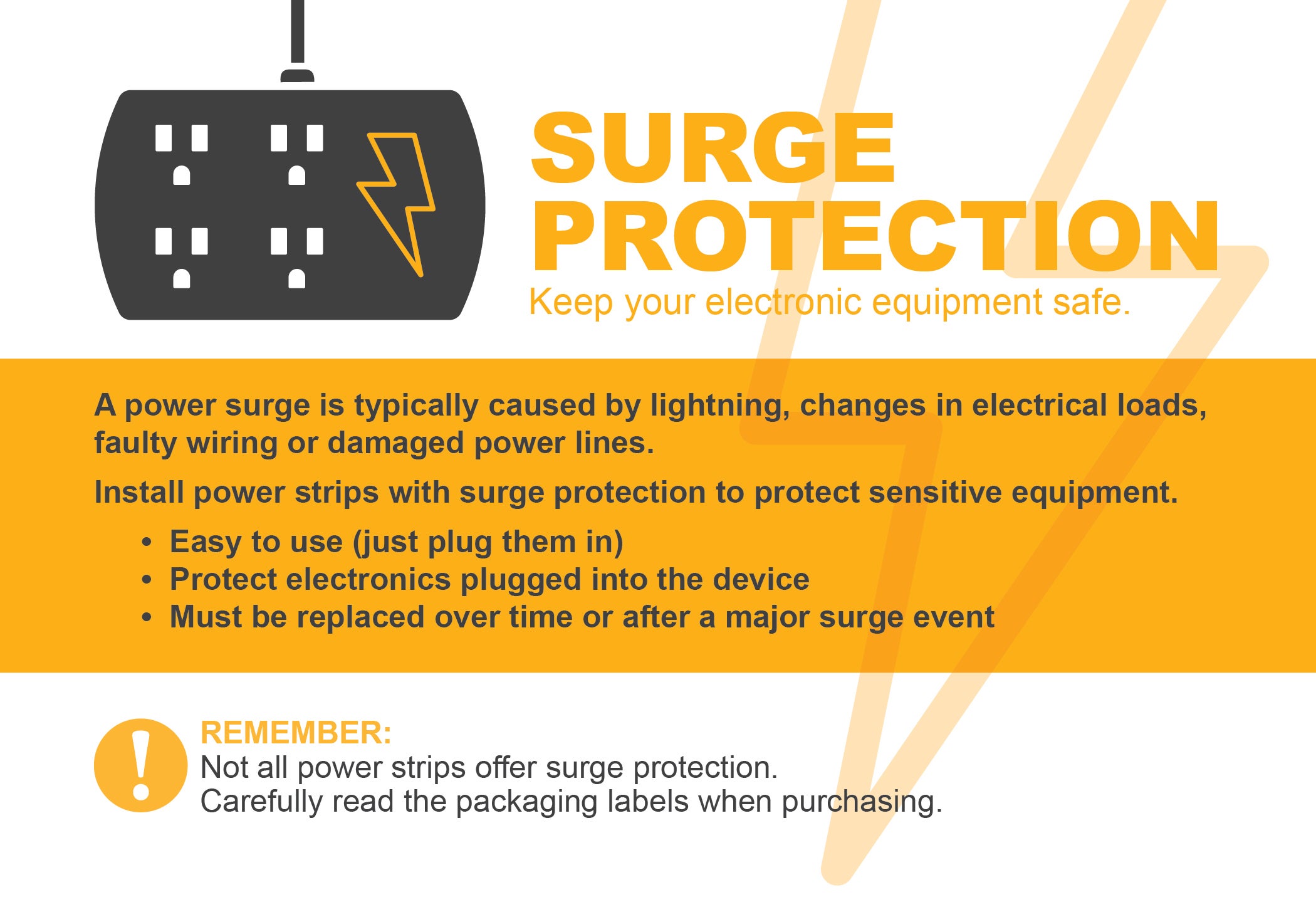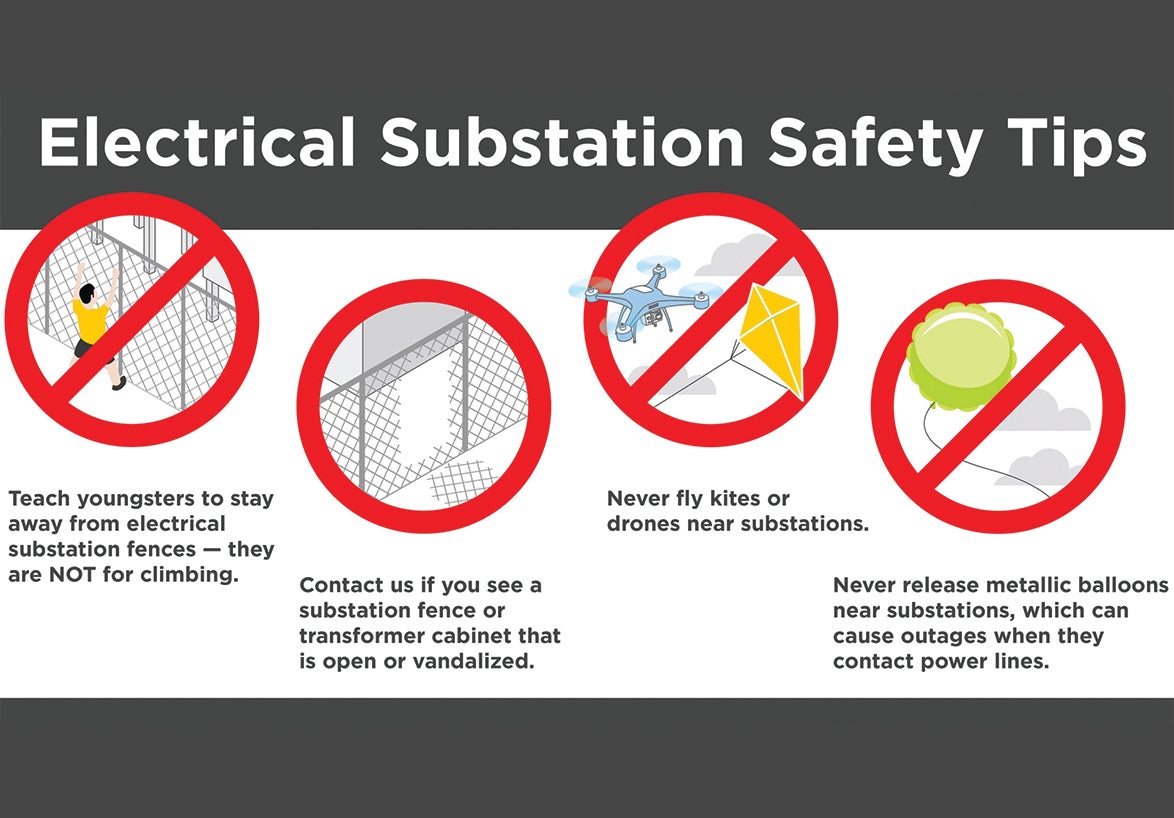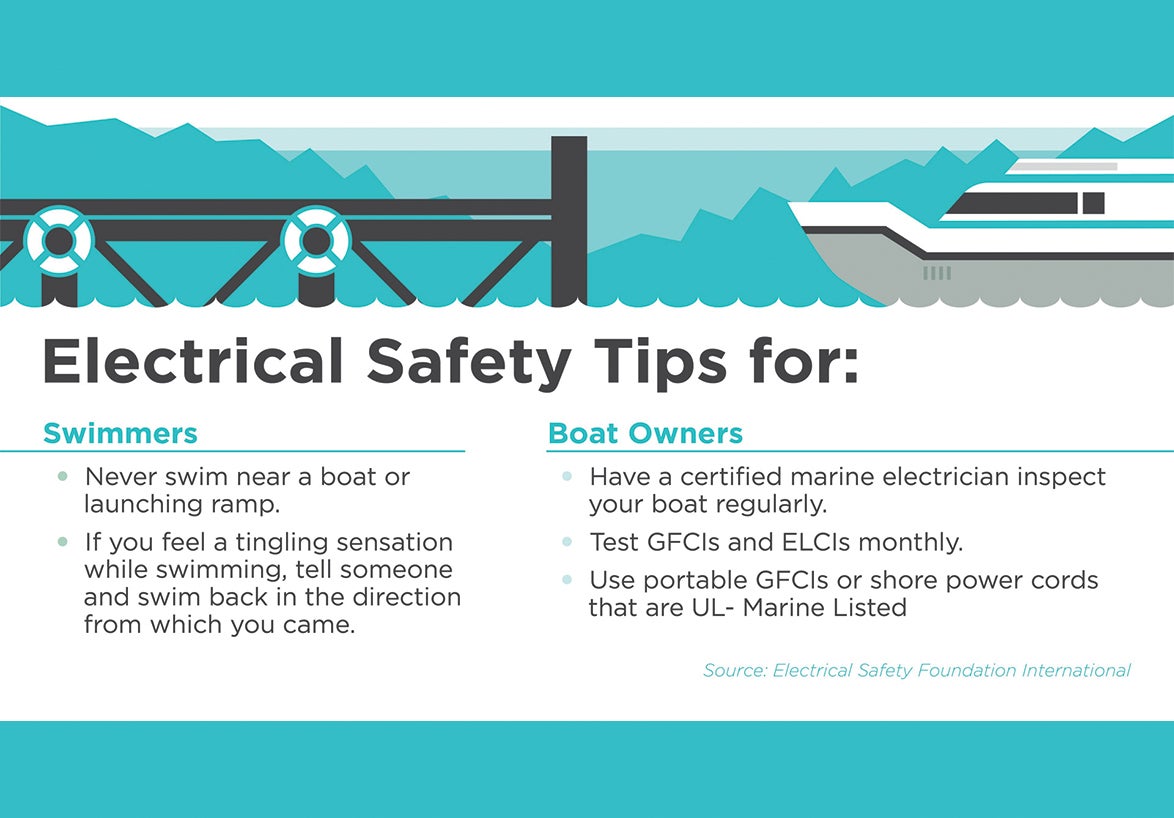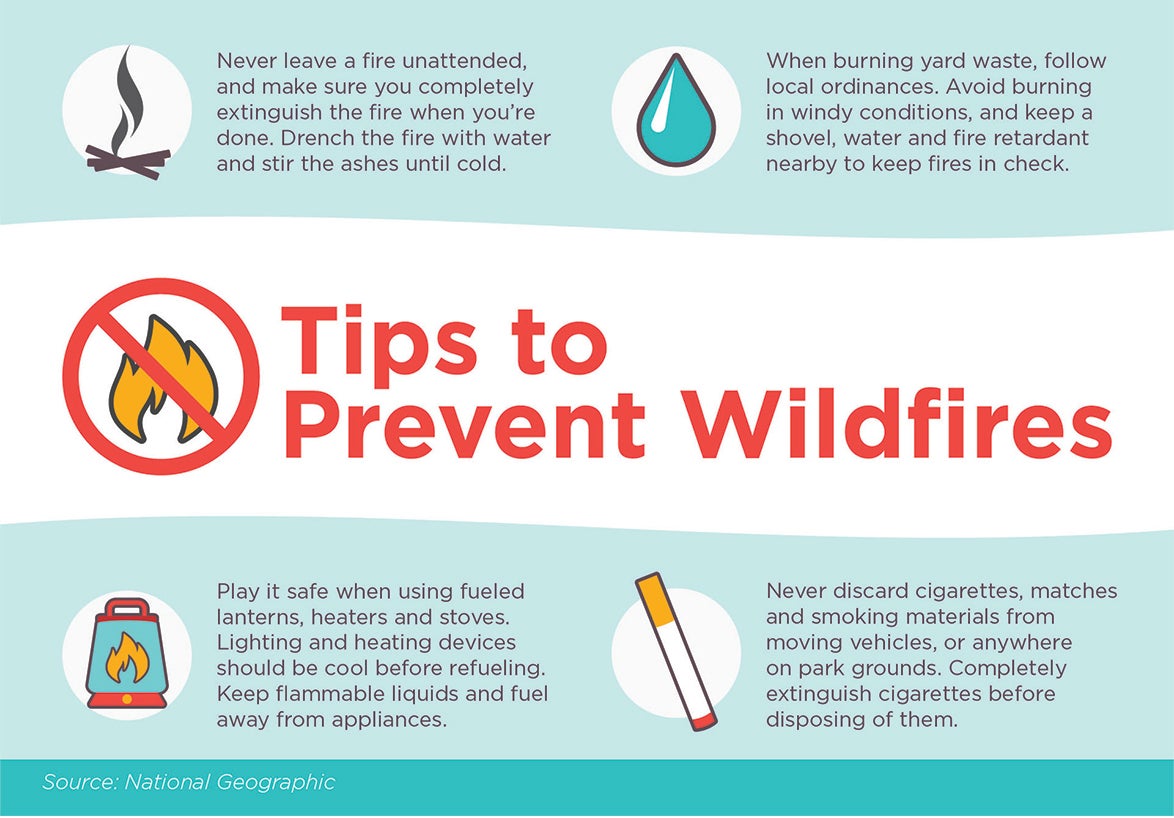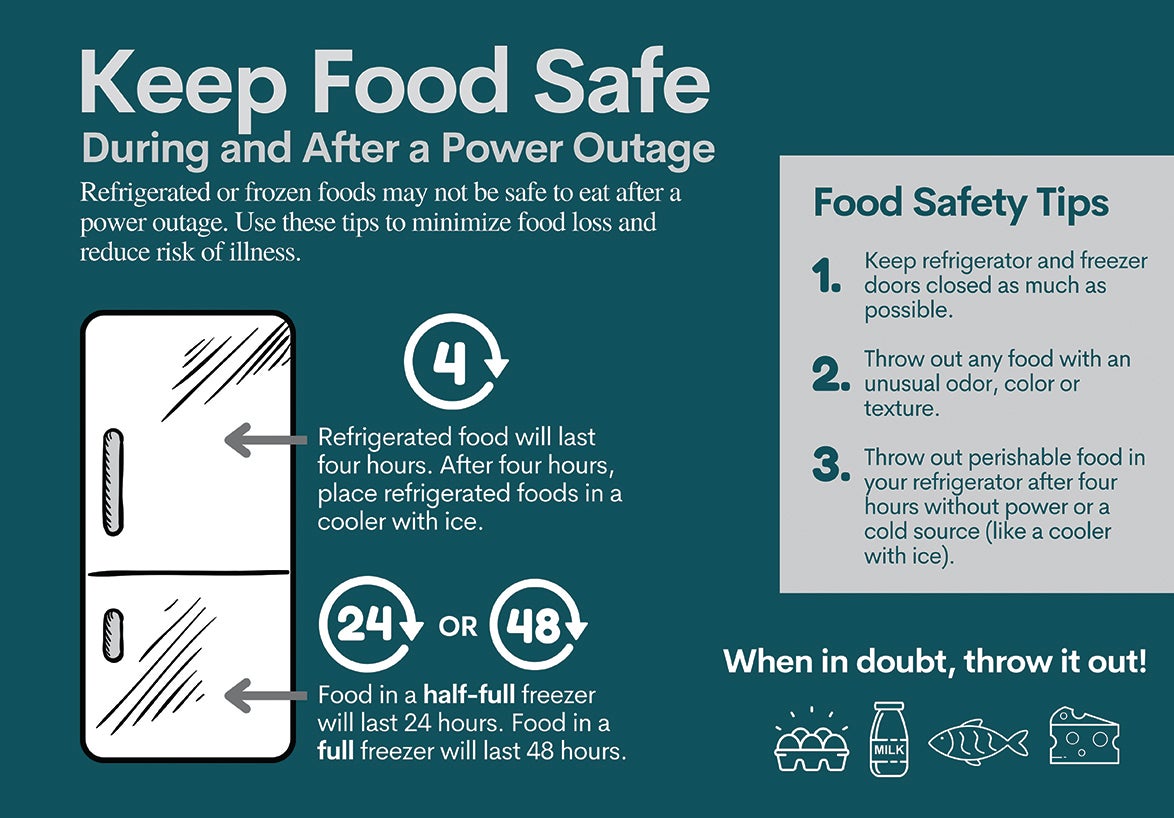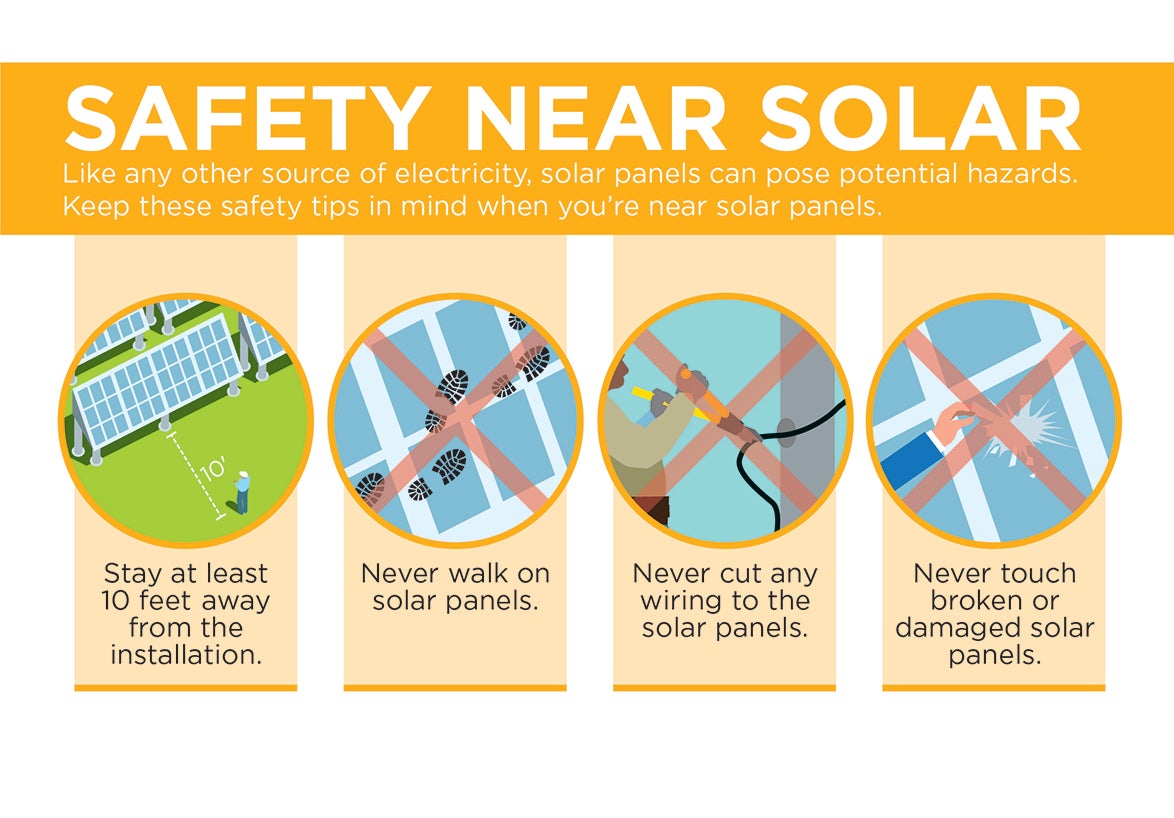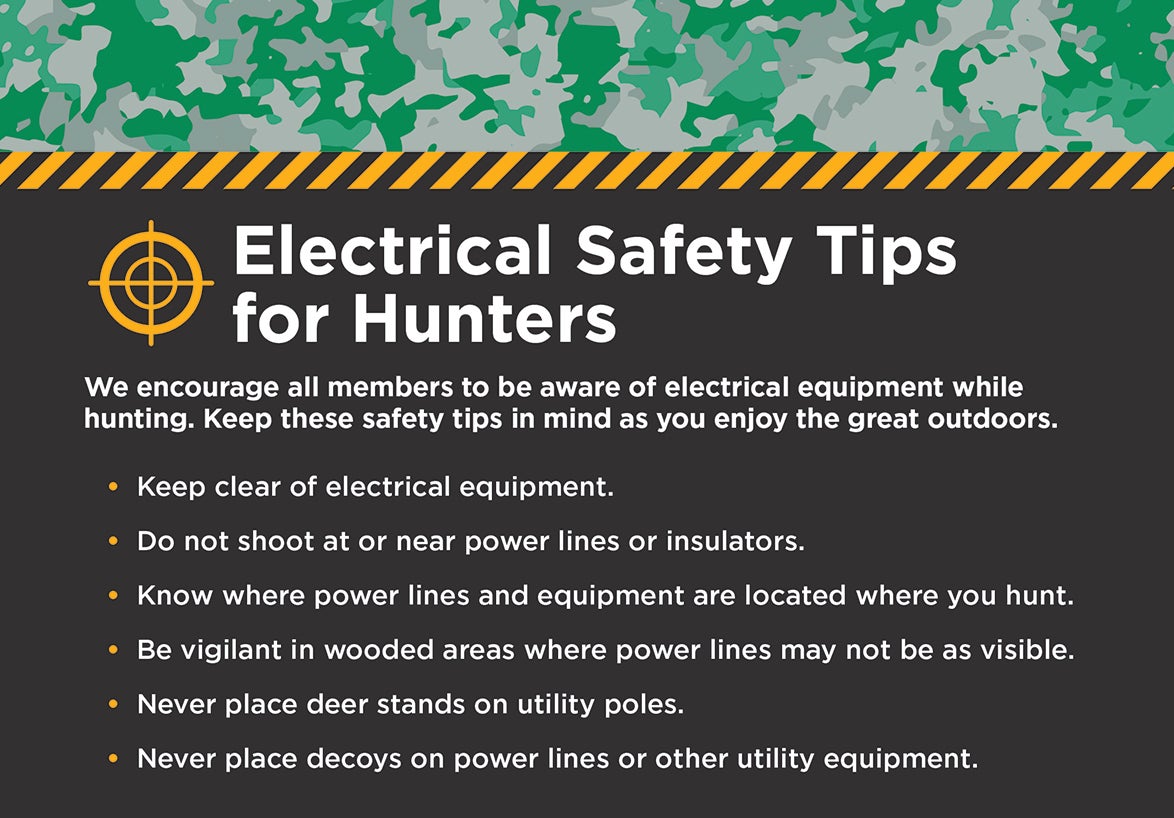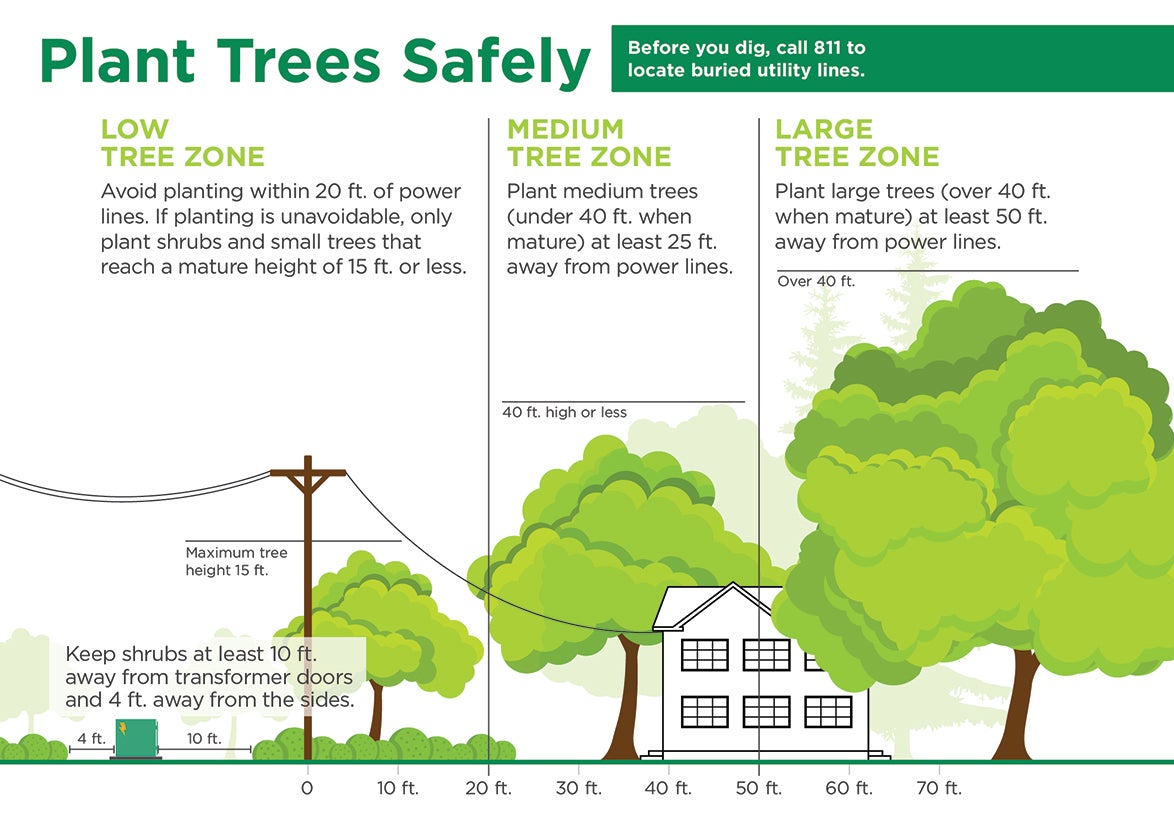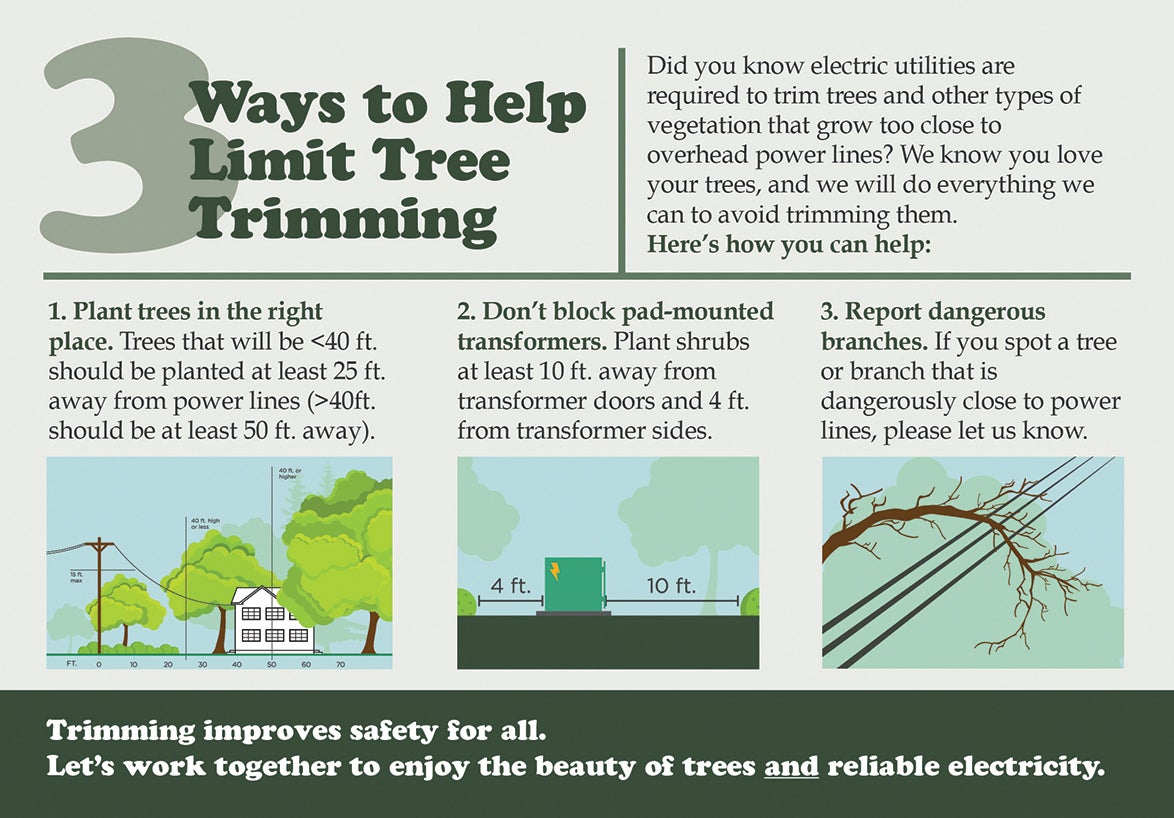Power Outage Safety
-
Stay away from power lines on the ground. Always assume downed lines are energized even if the lines are sagging or broken.
-
Do not attempt to remove trees or limbs from lines.
-
Do not sit in an idling car in the garage to get warm. Never use a camp stove or charcoal grill indoors to generate heat.
-
Lower the thermostat to a minimum.
-
Turn off all appliances that were on when the power went out.
-
Leave an outside light on so repair crews will know when power is back on.
-
Have a battery-operated radio or TV. In the case of large outages, KEC notifies the media of the status of the outage.
-
Have a cell phone or inexpensive, basic phone available to make and receive calls during an outage. Many of the latest phone models do not work without power.
How Our Outage System Works
A power outage reported using our outage number is automatically matched to our computer database using the phone number you call from. If you're not calling from the phone number in our system you can enter the number tied to your KEC account or you can enter your KEC account number and still be automatically matched. The location of the outage then lights up on a map. This is why it is beneficial for KEC to have on file the phone number you are most likely to call from to report a power outage.
- Call KEC at 208.765.1200 (or 1.877.744.1055 after hours) to report a downed line or car accident with a KEC pole.
- Never touch or go near a downed power line. Always assume power lines are energized.
- Don’t touch anything that may be touching a downed wire, such as a car.
If your car crashes into a utility pole, your vehicle may be charged with electricity. If this is the case and you step out of the car, you will become the electricity’s path to the ground and could be electrocuted.
Make sure you:
- Stay in the car, and tell others to do the same.
- Call 911 and mention the accident involves a utility pole.
- Do not leave your vehicle until a utility professional has told you it is safe to do so.
The only circumstance under which you should exit the vehicle
is if it is on fire. If necessary:
- Jump clear of the vehicle with your feet together and without touching the vehicle and ground at the same time.
- Continue to “bunny hop” with your feet together to safety. Doing this will ensure that you are only one point of contact and will not have different strengths of electric current running from one foot to another, which can be deadly.
If you come upon an accident involving power lines, do not approach the accident scene.
If you see someone approaching, warn them to stay away.
Here's how we prepare for storms:
- Continually monitoring weather.
- Notifying staff to be available to work.
- Annually performing reliability improvements, including right-of-way maintenance.
Here's what you can do before your power goes out:
- Sign up for KEC's outage alerts by logging in to your account.
- Charge cell phones.
- Have a plan for your pets and livestock.
- If your water supply is dependent on electricity, fill your bathtub with water.
- Ensure smoke alarm batteries have been changed recently. Also, consider how an outage will affect home security systems, garage doors and sprinkler systems.
- If you have a medical need that relies on electricity, the Food and Drug Administration published Guidance on Home Use Devices, recommending that individuals dependent on a medical device establish a plan for responding to a power outage and maintain medical information, a list of emergency contacts, extra oxygen tanks, battery backups and contact information for transportation services.
- Assemble an emergency storm kit containing:
- Flashlights and fresh batteries.
- Battery-powered radio or TV and extra batteries.
- Bottled water (one gallon per person per day).
- Nonperishable foods.
- Blankets, bedding or sleeping bags.
- First-aid kit and prescription medications.
- Hand-operated can opener.
- Special items for infants, the elderly or family members with special needs.
- A variety of hand tools.
- Identification and copies of important family documents in a waterproof container.
- Cash (ATMs may be unavailable).
- Remember, power outages can be reported at 1.877.744.1055 or through our SmartHub app.
If you have a medical need that relies on electricity, here’s how we can help you during an outage:
- Sign up for KEC outage alerts. Log in to your account online or download the SmartHub app on your phone to stay connected with KEC.
- You can report power outages and electrical emergencies by calling 1.877.744.1055, using your online account or by using the SmartHub app.
Here’s how you can help us restore power to members quickly and safely:
- Always report a power outage or electrical emergency, don’t assume someone else will call.
- If you have a generator installed, please call us at 208.765.1200. For the safety of our employees and the public, we track where backup generators are installed.
Other Resources
The Food and Drug Administration published Guidance on Home Use Devices, recommending that individuals dependent on a medical device establish a plan for responding to a power outage and maintain medical information, a list of emergency contacts, extra oxygen tanks, battery backups and contact information for transportation services.
Below are some tips provided by ready.gov to making a power outage plan for those who rely on electricity for medical needs.
- Plan alternative ways to charge your mobile devices, and communication and assistive technology devices before disaster strikes.
- Plan how you will address your dependence on electricity. Tell your power company if you use oxygen- or mechanical ventilation. Be very clear about what you can expect from them in a power outage.
- Before disaster strikes, you may register with your power company. They may alert you when power will be restored in an unplanned outage and before a planned outage. This is particularly important if you use oxygen or mechanical ventilation.
- If you cannot be without power, plan for how you will obtain power backup. If possible, have backup battery, generator, solar or alternate electrical resources. Explore newer solutions, and also consider foot pumps and other simple tools that might suffice when nothing else works.
- Charge devices that will maintain power to your equipment during electric outages.
- Purchase extra batteries for power wheelchairs or other battery-operated medical or assistive technology devices. Keep the batteries trickle charged at all times. Find out if you can charge your wheelchair or devices from a car or using rechargeable marine batteries. Make sure you assemble what you’ll need in advance.
- Backup chargers for a cell phone could include a hand-crank USB cell phone emergency charger, a solar charger, or a battery pack. Some weather radios have a built in hand crank charger.
- Backup chargers for a laptop or tablet could include a 12V USB adapter that plugs into a car, an inverter, or a battery jump pack with an USB port.
- Receive important information on a cell phone or smart phone. Sign up for emergency emails and text messages on your cell phone from your local government alert system.
- Plan how you are going to receive emergency information if you are unable to use a television, radio or computer. This may include having an adaptive weather alert system to alert you in the event of severe weather.
- Plan for medications that require refrigeration.
For more information visit Ready.gov or www.fda.gov.
KEC has its crews on call 24 hours a day and ready to be dispatched throughout our service territory. The following are a few reminders and safety tips for winter storms.
For Cold Weather:
- Do not sit in an idling car in the garage to get warm. Never use a camp stove or charcoal grill indoors to generate heat.
- Consider opening kitchen and bathroom cabinet doors to allow warmer room air to circulate around the plumbing.
- Let the cold water drip from the faucet served by exposed pipes.
- If you will be going away during cold weather, leave the heat in your home set to a temperature no lower than 55ºF.
Power Outage Safety:
- Stay away from power lines on the ground. Always assume downed lines are energized even if the lines are sagging or broken. Call KEC at 1.877.744.1055 right away to report them.
- Do not attempt to remove trees or limbs from lines.
- In the case of large outages in rural/limited access areas where snow removal has not been consistent, members should be prepared for lengthy outages.
- When shoveling snow off the roof – look up and be sure there are no power lines above you.
- If you are able, keep your driveway plowed to help our crews have better access.
- Turn off all appliances that were on when the power went out.
- Leave an outside light on so repair crews will know when power is back on.
- Have a battery-operated radio or TV. In the case of large outages, KEC notifies the media of the status of the outage.
- Have a cell phone or inexpensive, basic phone available to make and receive calls during an outage. Many phone models do not work without power.
- Generators can cause a serious safety problem if improperly installed and could cause injury to utility workers and the general public. All backup generator installations must have a transfer switch installed in accordance with the requirements of the National Electric Code. Call the KEC office at 208.765.1200 for more information.
For more tips on how to develop a family emergency plan and what to include in an emergency storm kit, visit the American Red Cross website.
If a power outage does occur, please call the KEC outage line at 1.877.744.1055. Our outage management system tracks calls based on caller id. When calling in power outages KEC members should call from the phone number KEC has in its system to identify the location. If you aren’t sure which number we have in our system for you please call our office at 208.765.1200.
Weather-related:
- High winds
- Lightning
- Ice or snow
Others:
- Farm equipment or vehicle contact with poles or wires
- Animals (squirrels, raccoons, birds, etc.)
- Trees and branches in contact with lines
- High power demand that causes overload
The following are some of the common questions (and answers) about power outages:
Why couldn’t you provide restoration estimates?
Generally, KEC includes estimated times of restoration on our outage map (www.kec.com/outage-map), when they are available. During severe storms such as this one, it is very difficult to make accurate estimates, especially when so many trees and poles are broken.
How do you determine where to restore power first?
During a storm, crews work to restore power to the greatest number of members in the shortest time possible. In this case, crews worked to restore power to areas without broken poles first as it can take up to 10 hours to repair a broken pole.
Why doesn’t KEC put all the power lines underground?
Currently more than half of our power lines have been built underground. Almost all new construction is also built underground. Underground lines can be three times the cost of overhead lines. After the wind and snowstorms of 2015 KEC was awarded more than $10 million in special grant funding from FEMA to convert approximately 50 miles of our most problematic overhead lines to underground.
KEC is currently working to apply for additional FEMA funding to convert more lines to underground.
What is KEC doing to keep trees from falling on lines?
To minimize the risk of trees contacting our overhead lines, KEC has an aggressive vegetation management plan. We trim rights-of-way to provide for the minimum clearance distance of 30 feet, or 15 feet either side of the power line. We also ask members to call and report any trees they see close to our primary lines or dead trees that may fall on our lines. KEC will remove trees threatening our lines at no cost to landowners. KEC does not trim service lines (the line from KEC’s transformer to your house). That is the homeowner’s responsibility. We will come out at no charge and drop the service line so the member can trim service line trees safely.
Should I help your crews by cutting trees that have fallen on power lines?
If a tree has fallen into power lines on your property, please stay away and contact us as soon as possible. Downed power lines are dangerous. Never touch them. For safety’s sake, always assume that a fallen power line is live, and follow these guidelines:
- Avoid touching the downed line with your hand or an object, such as a stick, broom or pole.
- Avoid touching anything, such as a car, object or equipment, or anyone who is in contact with a fallen power line.
- Avoid driving over a fallen power line.
- Trees and water conduct electricity. Do not spray water at a live power line. You can become electricity’s path to the ground if you are touching water that touches electricity resulting in injury or death.
Where can I get updates during outages?
We encourage members to sign up for outage alerts by text or email using your SmartHub account. Remember to keep your contact information (phone and email) updated with us so we can notify you in the event of planned power outages. During large outages, updates are also available at: www.facebook.com/KootenaiElectric.
Additional Safety Information
Know What's Below
Call Before You Dig is a free service up to KEC's meter that locates underground wires and lines in Kootenai County. Call the toll-free number, 811, at least two business days but no more than ten business days before digging or excavating and have the following information ready: start date, phone number, type of work, job location and special marking instructions.
After making this call the locations of underground wires and lines will be marked. This prevents digging equipment from hitting or cutting off power, water, phone, cable or gas lines. Accidental contact with a line can result in serious injury and possibly death. Damages to these lines can disrupt service to an entire neighborhood, and could include fines and repair costs.
Please note: underground lines that extend beyond the meter or are on member-owned equipment may not be located unless you call for a private locate. To learn more visit the Idaho Digline or view the Member vs. KEC Responsibilities information below.
For the safety of KEC employees and the public we track where backup generators are installed on our system and request all members who have installed generators call KEC at 208.765.1200.
Generators can cause serious safety problems if improperly installed and could cause injury to KEC workers and the general public. All backup generator installations should have a transfer switch installed in accordance with the requirements of the National Electric Code. Transfer switch installations must be inspected by the State Electrical Inspector and we request that members provide KEC with a copy of the State Electrical Permit for the transfer switch installation.
Also, GenerLink™ has been approved for the KEC system. This is a five-inch device (for 200 amp service only) installed behind your electric meter by a KEC approved, licensed electrical contractor. When you connect a portable generator to GenerLink™ and start it up, GenerLink™ automatically disconnects your house from the electric utility grid preventing the possibility of back feed. Call us at 208.765.1200 or email kec@kec.com for more information.
We also ask that members contact us at 208.765.1200 if they have any on-site generation (such as wind or solar).

Knowing the safety precautions and legal responsibilities of your electric service is important for all KEC members. You may not be aware of what equipment is the homeowner’s responsibility and what is KEC’s responsibility. Electric meters are the property of KEC. Removing the meter with current flowing through it can lead to an electrical explosion. The person working with the meter could be injured or killed. If you’re planning on doing electrical work, contact KEC and we will send certified personnel to your site. Under no circumstance should meters be removed or relocated—temporarily or permanently—by anyone other than authorized KEC employees.
For overhead service, KEC is responsible for the cable that runs from the utility pole to your home. This wire is called a “service line.” The service line connects to your house at the “service mast,” a vertical pipe-like structure attached to the top of the box that houses your electric meter. The service mast and the box that holds the meter are the homeowner’s property and responsibility.
For underground service, KEC is responsible for the transformer, underground wire from the transformer to the meter, and the meter. If you have any questions about your electric service responsibilities, please call KEC at 208.765.1200.
Overhead Hazards
Overhead power lines carrying 750 volts or more are defined as high voltage and are usually not insulated. Lower voltage lines may be, but you still should not touch them.
- Any overhead wire is a potential hazard. Keep at least ten feet away from high voltage overhead power lines and keep any tools or equipment away also.
- Use extreme caution when raising, lowering or moving pipe, rods, ladders, equipment or other metal materials near overhead power lines.
- When guiding a crane load line, make sure it and the crane stay at least ten feet away from live, high voltage power lines.
- Use extreme caution when painting or cleaning in an area where overhead power lines pass near to a building. Do not touch service wires that enter a building.
- Do not work on trees or signs closer than ten feet to live, high voltage overhead power lines unless you are trained for the job. If you must work close to such power lines, ask your supervisor to arrange with the power company to guard the lines, disconnect or re-route them.
- Never climb power poles or install equipment on them.
- If you are outdoors during an electrical storm: stay away from large trees or poles, especially if they are the tallest in the area; and:
- If you are in a large flat area such as a field or lake, crouch down with your feet close together and get to shelter as soon as possible. Do not lie flat. Keep to low areas rather than on high points such as ridges of land.
Underground hazards
In many areas, electrical equipment may be located underground.
- Use extreme caution when digging or trenching any area serviced by underground power lines. Many new housing developments as well as older commercial areas have high voltage electrical cables running underground.
- Find out the location of underground power lines before digging deeper than 1.5 feet. Have the power company identify the location of underground power lines if there is any doubt. In Kootenai County call 811.
- Stop digging immediately if you run into a yellow plastic warning ribbon or plank in an area you are digging. (Not all underground cables are marked, although many are.)
- Do not drive ground rods or other objects more than 1.5 feet into the ground within ten feet of an underground cable. Do not plant trees over underground cables.
Equipment hazards
Electrical equipment and appliances sometimes pose safety hazards.
- Check that portable power tools are double insulated or are plugged in with a three-prong plug. Never break off or by-pass the third prong.
- Know where the circuit shut-off switch is for any electrical equipment you are using. Ask for proper instruction before using equipment you are not familiar with. Never turn on a machine or circuit if it has an "Out of Service" sign on it.
- Use a fused power bar with a three-prong plug to plug more than one piece of equipment into a single power outlet. Be sure the total power drawn is less than the circuit rating.
- Use only three-wire extension cords rated for exterior use in outdoor locations.
- Never run power cords or extension cords over or through water. Never touch an electrical tool if your hands or feet are in contact with water. Never use electrical equipment outdoors when it is raining.
- If a fuse or circuit breaker repeatedly blows, move the equipment to another circuit. If it continues to blow, ask to have a qualified electrician check the circuit.
- Roll and store extension cords properly to prevent damage. Discard any cords with frayed, cracked or missing insulation. Keep extension cords away from areas where vehicles may pass over them.
- Disconnect tools before moving, adjusting, cleaning or repairing them. Have them "locked out" with your personal lock if they cannot be disconnected from the main power supply.
- Only qualified electricians should work on electrical service equipment or wiring.
If an accident happens
If you are the first person on the scene of an electrical accident, use extreme caution. There may still be live electrical equipment in the area. Don't become the next victim. Before you do anything else, call for trained emergency help unless the danger is clearly over. If there is any question that a risk may continue, follow this procedure:
- Call for trained emergency help. Keep everyone well back until the power is off.
- If the victim is no longer in contact with the power source, help the victim move to a safe place. Offer first aid if necessary.
- If the victim is still in contact with a low voltage power source (less than 750 volts), quickly look for the electrical power source and disconnect if at the source if possible.
- If this is not practical, you may be able to separate the victim from the power source using a dry non-conductive broom handle or other dry insulating material. Do not directly touch the victim unless he or she is separated from the power source. Although many materials are non-conductors at any voltages, they must be dry.
- If you cannot separate the person from the low voltage power source, stay clear and make sure others stay clear too.
- If the accident involves high voltage wires (above 750 volts), the ground itself may be hazardous. Stay at least 30 feet away and keep others away until trained emergency help arrives.
- If there is a danger of fire, call the fire department. Then use a chemical or gas fire extinguisher if possible. Never use water.
- If you are in a vehicle or on a machine that is in contact with electricity, stay where you are. You are safer where you are. If you attempt to leave, you may become a path for the electricity to ground.
- If you must leave a vehicle or machine that is in contact with electricity because of fire or possible explosion, do not touch the vehicle and the ground at the same time. Jump clear of the vehicle. Land with your feet close together. Do not fall onto your hands. You may become a path for electricity to travel between different areas in the ground. HOP OR SHUFFLE TO SAFETY. Keeping your feet together, hop or shuffle at least 30 feet from the power source.
More information on electrical safety can be found on the Electrical Safety Foundation Internationalwebsite.
The meter base is typically a rectangular metal box mounted near or on the outside of your home or business that the meter plugs into. Each meter base might look a little different. It belongs to the property owner and they are responsible for maintaining it in good serviceable order. If it’s damaged by weather or by any kind of accident, repair is the property owner’s responsibility. If you inspect your meter base and believe it needs repair, we encourage you to contact a licensed electrician. Alternatively, you can take a picture of your meter base and send it to KEC using the form below. KEC staff may be able to confirm those concerns or identify other issues. A damaged meter base can be a safety hazard for both members and KEC employees. Please note: the property owner is responsible for the meter base on their property. KEC does not accept responsibility for the meter base if you send information or images using the form below.
Many electric, water, and natural gas customers throughout the country are being targeted by impostor utility scams each day. Scammers typically use phone, in-person, and online tactics to target customers. Raising awareness and educating customers about scams is Utilities United Against Scams (UUAS) top priority. UUAS will continue to help spread awareness of the suspicious behaviors and the evolving tactics that scammers use to target customers. It is important that customers call their utilities directly to check on the status of their accounts if they are ever unsure about the authenticity of a caller or the identity of a service worker, or if they suspect any fraudulent activity.
Sometimes after a power outage we receive questions and comments from members about their smoke alarms going off or chirping. Many smoke alarms are powered by AC (alternating current) and use a battery backup. When the power goes out some units chirp to inform you they are running out of batteries. If this happens the batteries should be changed right away. Below are some other smoke alarm reminders:
- Test your alarms every month to be sure they're working properly.
- A good time to remember to change the batteries is when you change your clocks twice a year as daylight savings time begins and ends (if you hear the chirping low-battery signal, replace batteries immediately).
- Replace your alarms every 10 years; check the alarm for the manufacture date, and toss it if it’s at least 10 years old.
- Review the manufacturer’s documentation on your type of alarm.
To learn more visit: https://www.usfa.fema.gov/prevention/home-fires/prepare-for-fire/smoke-…


